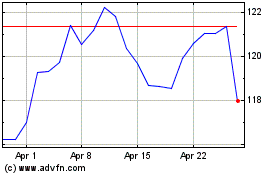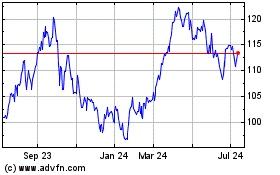Oil companies are pumping more crude off the U.S. coast in the
Gulf of Mexico, a surprising trend that shows the resilience of the
nation's energy industry.
Despite the worst price downturn in a generation, so much oil is
starting to pour forth from offshore fields near Louisiana and
Texas that it is partially offsetting declining output from shale
regions on shore and propping up total American oil output.
The U.S. is currently pumping about 8.7 million barrels a day,
480,000 less than at the end of last year, according to the Energy
Information Administration, as low prices spur companies to shut
down new exploration and some existing shale-oil wells begin to
peter out.
Production is forecast to drop further to 8.5 million barrels a
day later this year.
But well over 500,000 barrels a day of new Gulf crude is set to
come online this year and next, according to a Wall Street Journal
analysis of government data, company presentations and regulatory
filings.
The Gulf surge threatens to prolong the glut of crude that has
built up in storage around the U.S. and helped push down prices,
said Roger Diwan, vice president of financial services at IHS
Energy.
"The projects are coming faster and sometimes bigger than
expected," he said. "The ramp-up seems to have accelerated during
low prices."
Gulf production is rising in part because a handful of massive
oil fields sanctioned for development years ago by companies like
Freeport McMoRan Inc. and BP PLC when prices were higher are
starting to pump oil this summer and fall.
But it is also going up because companies are finding that
smaller satellite fields can be tapped relatively cheaply by
linking them to existing offshore oil platforms by way of
underwater pipelines.
While production from many of these so-called tieback wells is
reflected in forecasts from banks and analysts, the Journal
analysis found that some of it appears to have been
undercounted.
American offshore oil production is on track to set a record in
2017, with 1.91 million barrels flowing out of the Gulf by year's
end, according to the U.S. Energy Department. That would be a 24%
surge over 2015's offshore oil output of 1.54 million barrels a day
and would beat a previous high of 1.56 million barrels a day set in
2009, the year before BP's Deepwater Horizon oil spill disaster
temporarily shut down drilling, federal data show.
While the conventional wisdom in the energy industry was that
deep-water oil development was too expensive at current prices of
around $50 a barrel, producers looking to squeeze out profits from
existing investments have rushed to tap tiny wells offshore and
connect them to oil platforms.
One of them is Exxon Mobil Corp. It started pumping 13,000
barrels a day at the end of April from a well 200 miles south of
New Orleans known as Julia, whose production is being piped back to
Chevron Corp.'s Jack/St. Malo platform. Exxon expects
Julia's production to eventually hit 34,000 barrels a day.
Big oil companies, including BP and Royal Dutch Shell PLC as
well as independent exploration outfits like Anadarko Petroleum
Corp. and Noble Energy Inc., are pursuing tiebacks. None would
quantify how much production they expect to add from the projects,
citing competitive reasons.
Noble, which has prioritized tiebacks over some shale
development, nearly doubled its Gulf output in the first quarter
and has another offshore well starting to pump later this summer.
Anadarko has more than 30 tieback well prospects in satellite
fields, and will drill up to seven this year, according to Bob
Gwin, chief financial officer.
"At $60 oil, which hopefully is on the horizon, these
opportunities have better than a 70% rate of return," Mr. Gwin told
analysts at the UBS Global Oil and Gas Conference in Austin last
month.
Tieback wells are drilled in fields not large enough to justify
the hefty expense of building new giant floating installations in
the Gulf. Some tieback wells are profitable when oil trades as low
as $25 to $30 a barrel, and many more can make money when crude is
between $30 and $40 a barrel, according to analysts at Wood
Mackenzie, a consulting firm in Houston.
Constructing the massive offshore oil platforms that bob in
thousands of feet of water and suck crude up from beneath the ocean
floor can take nearly a decade and billions of dollars. Once built,
"you might as well make the most of it" by maximizing the oil each
platform pumps and processes, said Terry Yen, an analyst with the
U.S. Energy Information Administration.
Deep-water drilling costs have fallen and will continue to drop
as long-term contracts on rigs expire, according to IHS
Petrodata.
Companies are also getting better at accessing deep-water finds.
Shell saved $1 billion drilling its Stones project in ultra-deep
waters 200 miles southwest of New Orleans, which will start up next
year, by using a slim-well design offshore engineers borrowed from
onshore shale operations.
Chevron recently executed a tieback to its Tahiti platform 190
miles south of New Orleans using a technique that allowed it to tap
two oil reservoirs stacked on top on each other, resulting in a
well that will produce 50% more oil and gas than originally
thought, the company said in a recent earnings call.
Gulf production has also grown thanks to the ingenuity of
smaller players such as LLOG Exploration Co., a private deep-water
driller based in Covington, La.
It pioneered a platform-building process that it can bring new
projects online in half the time it takes bigger rivals, said
Gordon Loy, a researcher at Wood Mackenzie.
Write to Erin Ailworth at Erin.Ailworth@wsj.com
(END) Dow Jones Newswires
June 23, 2016 14:05 ET (18:05 GMT)
Copyright (c) 2016 Dow Jones & Company, Inc.
Exxon Mobil (NYSE:XOM)
Historical Stock Chart
From Mar 2024 to Apr 2024

Exxon Mobil (NYSE:XOM)
Historical Stock Chart
From Apr 2023 to Apr 2024
